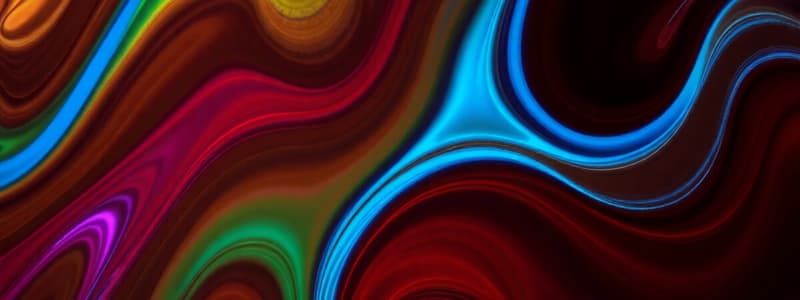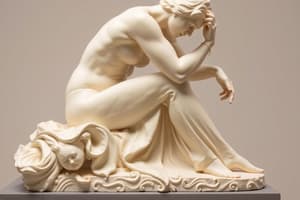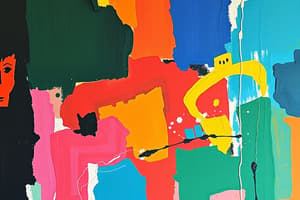Podcast
Questions and Answers
Which statement best describes the relationship between artistic and creative abilities?
Which statement best describes the relationship between artistic and creative abilities?
- Creative ability encompasses imagination and problem-solving talent, while artistic ability emphasizes skills in fine art creation. (correct)
- Artistic ability is rooted in problem-solving, while creative ability is rooted in fine art creation.
- Artistic ability encompasses creative ability, focusing specifically on imagination within fine art.
- Creative ability focuses solely on imagination within problem-solving in fine art, while artistic ability tackles imagination in any domain.
According to Eliot Eisner, what is a key benefit of incorporating arts into education?
According to Eliot Eisner, what is a key benefit of incorporating arts into education?
- Arts integration emphasizes memorization of historical facts and figures.
- Arts promote standardized assessment scores through repetitive exercises.
- Arts education primarily enhances technical skills, preparing students for vocational careers.
- Arts provide open-ended tasks that cultivate imagination, a critical human aptitude. (correct)
Which of the following actions best exemplifies an artistically literate individual?
Which of the following actions best exemplifies an artistically literate individual?
- Relying solely on technical skill to replicate existing artworks flawlessly.
- Actively seeking and supporting diverse artistic experiences for intellectual stimulation. (correct)
- Strictly adhering to traditional art forms and techniques to preserve cultural heritage.
- Avoiding personal creative expression to maintain objectivity in art appreciation.
In art, what is the primary role of 'line' as an element?
In art, what is the primary role of 'line' as an element?
If an artist wants to convey a sense of calmness and stability, which type of lines would be most effective?
If an artist wants to convey a sense of calmness and stability, which type of lines would be most effective?
What are the three dimensions or attributes of color?
What are the three dimensions or attributes of color?
An artist uses primarily blue tones in a painting. Which psychological effect is most likely being conveyed?
An artist uses primarily blue tones in a painting. Which psychological effect is most likely being conveyed?
Which color combination would best express sympathy and gratitude?
Which color combination would best express sympathy and gratitude?
Which of the following describes 'texture' as an element of art?
Which of the following describes 'texture' as an element of art?
What distinguishes aerial perspective from linear perspective?
What distinguishes aerial perspective from linear perspective?
A sculptor wants to emphasize the three-dimensional aspect of a statue. Which element of art should they focus on?
A sculptor wants to emphasize the three-dimensional aspect of a statue. Which element of art should they focus on?
What principle of design ensures that different elements in a design look as though they belong together?
What principle of design ensures that different elements in a design look as though they belong together?
In art, what does 'proportion' refer to?
In art, what does 'proportion' refer to?
An artist repeats a pattern of lines and colors throughout a painting. Which principle of design are they primarily utilizing?
An artist repeats a pattern of lines and colors throughout a painting. Which principle of design are they primarily utilizing?
An artist places a bright red apple in the center of an otherwise muted still life drawing. Which principle of design is being used?
An artist places a bright red apple in the center of an otherwise muted still life drawing. Which principle of design is being used?
Flashcards
Art Definition
Art Definition
A broad range of human activities creating visual, auditory, or performed artifacts (artwork) to express the author's skill.
Creativity
Creativity
The ability to generate or recognize ideas or possibilities to solve problems and communicate.
Artistic Ability
Artistic Ability
Skills and talent focused on the creation of fine art.
Creative Ability
Creative Ability
Signup and view all the flashcards
Artistically Literate Individuals
Artistically Literate Individuals
Signup and view all the flashcards
Line (Element of Art)
Line (Element of Art)
Signup and view all the flashcards
Color
Color
Signup and view all the flashcards
Hue
Hue
Signup and view all the flashcards
Value (Color)
Value (Color)
Signup and view all the flashcards
Saturation (Color)
Saturation (Color)
Signup and view all the flashcards
Texture
Texture
Signup and view all the flashcards
Perspective
Perspective
Signup and view all the flashcards
Space
Space
Signup and view all the flashcards
Form/Shape
Form/Shape
Signup and view all the flashcards
Harmony (Design)
Harmony (Design)
Signup and view all the flashcards
Study Notes
- Art is a broad range of human activities that create visual, auditory, or performed artifacts (artwork) to express the author's imaginative or technical skill.
- Creativity is the ability to generate or recognize ideas, alternatives, or possibilities that may be useful to solve problems, communicate with others, and entertain.
Artistic vs. Creative Ability
- Artistic ability refers to skills and talent in fine art creation.
- Creative ability refers to imagination and problem-solving talent.
Benefits of Arts
- Significant benefits exist for learning and engagement in schooling via the arts.
- Form and content cannot be separated; how something is communicated shapes the content of the experience.
- Open-ended tasks allow for imagination, which is an important human aptitude.
Characterizing Artistically Literate Individuals
- Artistically literate individuals use various artistic media, symbols, and metaphors.
- They develop personal creative realization.
- They cultivate cultural and historical connections.
- They find inspiration and intellectual stimulation in art.
- They support and seek artistic experiences.
Elements of Art
Line
- Defines shape, direction, and movement.
- Lines in art can convey the subject and meaning of the work.
- Horizontal lines suggest serenity, calmness, and stability.
- Vertical lines suggest poise, balance, force, and dynamism.
- Diagonal lines suggest action and movement, with the angle indicating the degree of action.
- Curved lines suggest flexibility, joyousness, and grace.
Color
- Wavelengths of light translated into visual perception by the brain.
Three dimensions of color:
- Hue: Names the color (e.g., red, blue).
- Value: Lightness or darkness of a color, also known as “chiaroscuro”.
- Saturation: Brightness or dullness of a color.
Psychological effects of Color:
- Black: Gloom and mourning.
- Blue: Calmness and peace.
- Red: Passion, energy, and warmth; can also represent fire, blood, danger, bravery, or war.
- Gray: Weight, solidity, and neutrality.
- Violet: Shadows, mourning, penance, royalty, and power.
- Green: Growth, freshness, and hope.
- White: Simplicity, clarity, purity, and innocence.
- Orange: Deliciousness, sweetness, and assertiveness.
- Yellow: Life, joy, sunshine, cheerfulness, warmth, freedom, and hospitality.
- Pink: Sympathy and gratitude.
- Brown: Wholesomeness, stability, and reliability.
Texture
- The feel of surfaces, perceived through the sense of touch (rough, smooth, shiny, etc.).
Perspective
- Allows us to perceive distance and the position of objects.
Two kinds of Perspective:
- Linear perspective uses converging lines.
- Aerial perspective uses relative distances of objects indicated by gradation of tone and color.
Space
- The distance or area between, around, above, below, or within shapes.
- Form/Shape:
- Describes the structure or shape of an object.
Volume
- The three-dimensional aspect of objects in art.
- Refers to solidity or thickness.
Principles of Design
Harmony
- A pleasing relationship between elements, essential to beauty.
- Achieved when the various parts of a design give an appearance of belonging together.
Balance
- Provides a sense of stability and rest.
- Exists when a feeling of balance and equilibrium is achieved.
Proportion
- Proper size relationships determined by comparing the sizes of different parts.
Rhythm
- Achieved by the regular or harmonious recurrence of lines, forms, and colors.
Emphasis
- Produced by a design or form that catches our attention while the rest are subordinated.
- Important in all art forms.
Movement
- Visual flow through the composition.
Contrast
- Created by placing or arranging very different things next to each other.
Types of Contrast:
- Color Contrast (different colors).
- Size Contrast (different sizes).
Studying That Suits You
Use AI to generate personalized quizzes and flashcards to suit your learning preferences.




